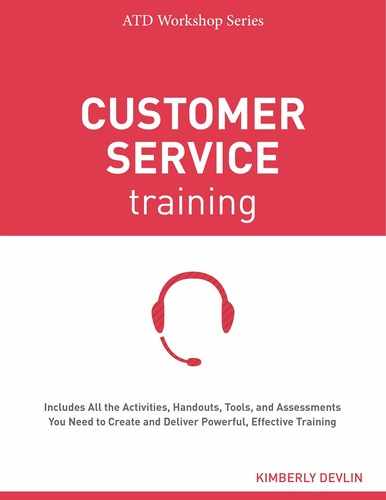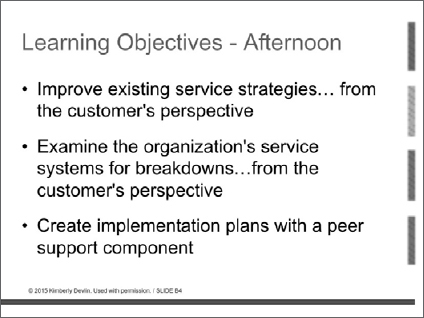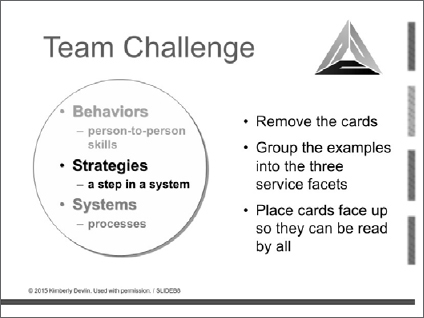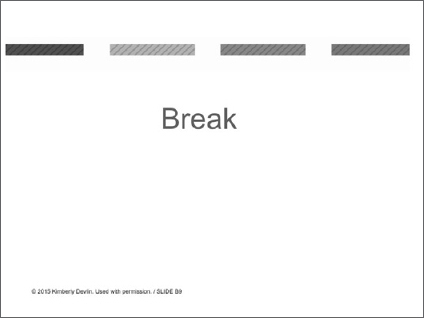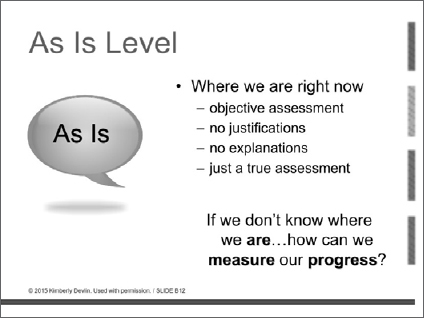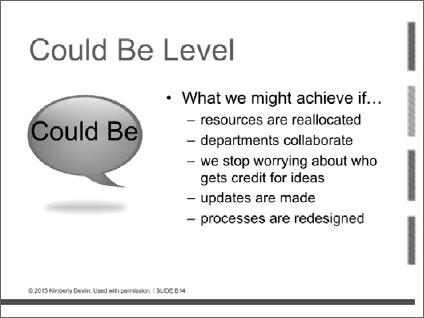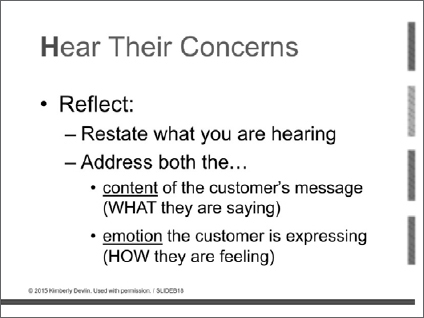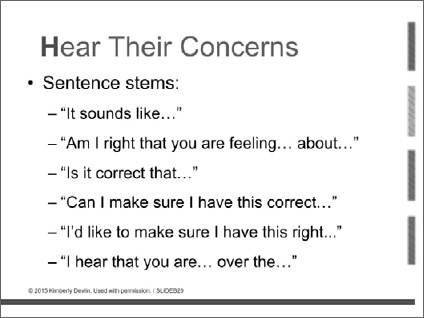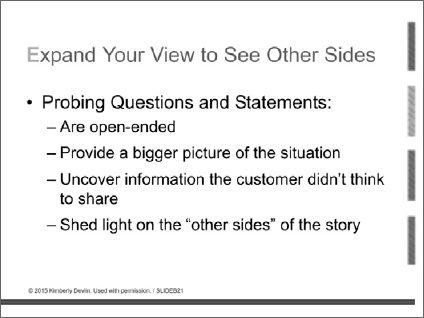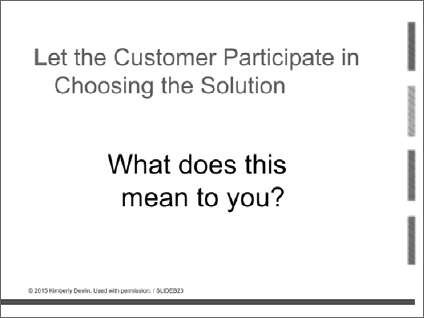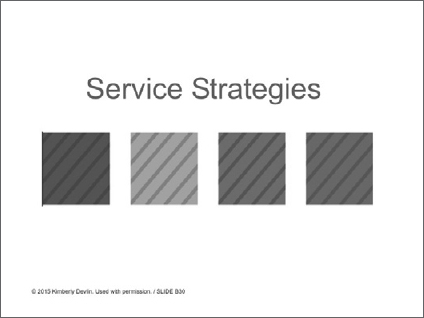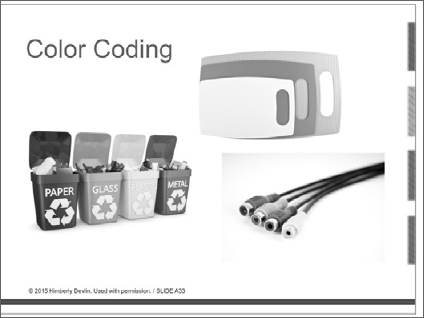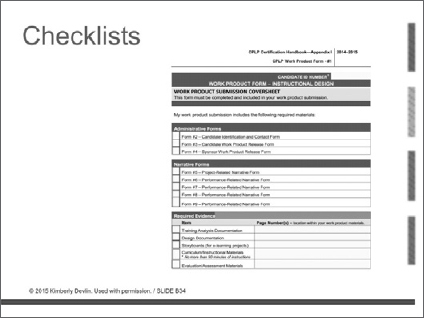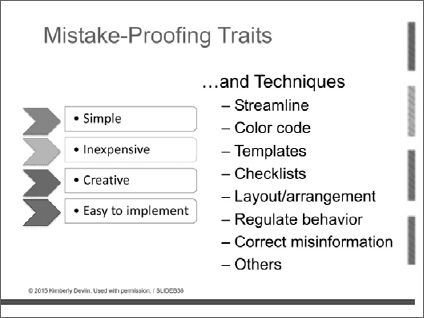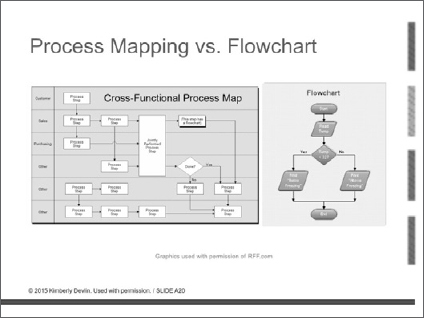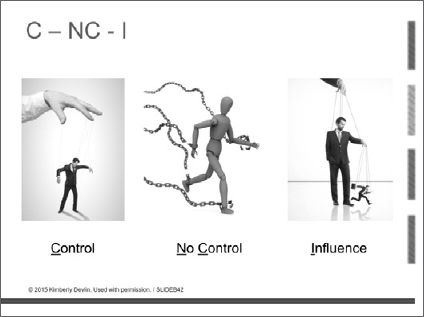Chapter 2
One-Day Customer Service Workshop: From the Customer’s Perspective
What’s in This Chapter
• Objectives of the one-day Customer Service Workshop
• Summary chart for the flow of content and activities
• One-day program agenda
![]()
This workshop’s primary focus is on service strategies—from the customer’s perspective. Throughout the activities and discussions, be prepared to drive home the importance of that point. Participants may be tempted to look at service strategies from the perspective of what is easiest or best for them, rather than for the customer. Redirect participants when needed, by asking questions such as “I hear you, I am just wondering how that is best for the customer?” or “And the way that benefits the customer is …?” An effectively worded redirection statement or question will have greater impact than “telling participants they are wrong.”
Participants leave this workshop with a service delivery model to apply immediately and a set of newly created process improvements to implement, making it a rewarding workshop to facilitate. Have fun with it and be sure to be prepared with concrete examples of where and how you are using the strategies in the workplace.
One-Day Workshop Objectives: From the Customer’s Perspective
Here are the learning objectives for the one-day workshop:
• Distinguish service behaviors from service strategies and service systems.
• Assess your service environment to target improvement opportunities.
• Follow the four-step HELP process for efficient customer interactions.
• Improve existing service strategies from the customer’s perspective.
• Examine the organization’s service systems for breakdowns from the customer’s perspective.
• Create implementation plans with a peer support component.
One-Day Workshop Overview
| TOPICS | TIMING |
| Welcome/Learning Activity 10: Initial Reactions | 15 minutes |
| Icebreaker/Learning Activity 11: Services Heroes | 20 minutes |
| Program Objectives and Social Agreements/Learning Activity 12: Prioritize Learning | 5 minutes |
| Learning Objective 1/Learning Activity 13: Interconnected Service Facets | 15 minutes |
| Learning Objective 1/Learning Activity 14: Do They Agree? | 25 minutes |
| BREAK | 15 minutes |
| Learning Objective 2/Learning Activity 15: Performance Improvement Service Levels | 20 minutes |
| Learning Objective 2/Learning Activity 16: Where Are We Now? | 15 minutes |
| Transition to Service Behaviors | |
| Learning Objective 3/Learning Activity 17: The HELP Process for Customer Interactions | 10 minutes |
| Learning Objective 3/Learning Activity 18: HELP the Customer: Interviews and Role Plays | 40 minutes |
| LUNCH | 60 minutes |
| Morning Review and Transition to Afternoon/Learning Activity 19: Quick Start | 10 minutes |
| Transition to Service Strategies | |
| Learning Objective 4/Learning Activity 20: Mistake Proofing | 20 minutes |
| Learning Objective 4/Learning Activity 21: Creating Mistake-Proof Techniques | 40 minutes |
| BREAK | 15 minutes |
| Learning Objective 4/Learning Activity 21: Creating Mistake-Proof Techniques (Take 2) | 30 minutes |
| Learning Objective 4/Learning Activity 22: Critiquing Mistake-Proof Techniques | 20 minutes |
| Transition to Service Systems | |
| Learning Objective 5/Learning Activity 23: Our Service Systems | 30 minutes |
| Learning Objective 5/Learning Activity 24: Where and How Can I Help? | 20 minutes |
| Learning Objective 6/Learning Activity 25: Where We Go From Here | 20 minutes |
| Course Closure | 5 minutes |
| TOTAL | 450 minutes (7.5 hours) |
A Word About Presentation Slides and Handouts
The presentation slides for this workshop have been animated to enhance their effectiveness. They can be used effectively in the pdf format (which are static), but if you choose to use the fully customizable versions and display the slides in slide show mode, many will have motion and builds. These animations are not merely movement; they are structured to enhance the visuals’ effectiveness, provide greater facilitative control of group discussions, manage cognitive load by chunking content in keeping with activity instructions, and in some instances, even provide feedback to the participants. Some animations are controlled by advancing the slides, and others are automated for you. This is intentional to guide certain activities and to offer you facilitative flexibility in others. Make time to familiarize yourself with the animations and plan how you will leverage them. You can run the workshop effectively using the pdf version; however, if you are accessing the presentation slides in their native format through an optional license, be sure to display them in slide show mode to derive their full benefit!
Please note that some slides in this workshop may also appear in the half-day or two-day workshops. Their animations here may be a bit different, in support of this workshop’s structure. Please be sure to familiarize yourself with these animations, even if you previously reviewed a different workshop’s visuals.
Each workshop has been designed as a continuous event. If facilitated that way, it may be logical for you to assemble all of the one-day workshop handouts and the assessment into a single, bound workbook to distribute to participants when they arrive. In this case, where the learning activities direct you to distribute a handout or assessment, you may want to make note of and, during the workshop, refer to the appropriate workbook pages. TIP: The assessment for Learning Activity 16 should fall between Handouts 17 and 18 if you choose to bind the participant materials.
For ease of navigation throughout the book, learning activities and handouts for all three workshops are numbered sequentially. Therefore, this workshop begins with Learning Activity 10 and the first handout is number 12. Each handout has a name as well. For a seamless participant experience, I suggest you refer to the handouts and assessment by name, page number (if bound), or renumber them to begin with number 1.
One-Day Workshop Agenda
You can use the agenda on the following pages as a quick-reference, birds-eye view to the workshop while you are facilitating. The learning activity pages in Chapter 11 will provide the detail in support of the workshop design, so be sure to have those pages available during your facilitation, as well as a reference set of the handouts.
| One Day: (9:00 a.m. to 4:30 p.m.) | ||
| TIMING | SLIDES | ACTIVITIES/NOTES/CONSIDERATIONS |
|
9:00 a.m. (15 min) |
Slide 1
|
Welcome/Learning Activity 10: Initial Reactions Plan an opener that sets the tone for the learning event. Start strong, grab your learners’ interest, and let them see the value of this learning event to their workplace performance. Use this learning activity to establish the learners’ expectations, not as housekeeping, introductions, or generalized “welcoming” comments (you will do that later in the workshop). Or, if you choose, the learning activity gives an alternate activity involving customer service statistics to substitute for the initial reactions exercise. Use the opener that will be most engaging for your particular group. |
|
9:15 a.m. (20 min) |
Slide 2
|
Icebreaker/Learning Activity 11: Service Heroes • Handout 12: Service Heroes This large group activity will help participants meet other participants and highlight their strengths in and strategies for effectively delivering customer service. Use the instructions in the learning activity to guide the exercise. To help participants get started, share an example of your own to demonstrate how they might complete Part 1 of the handout. Following the debrief, integrate a complete self-introduction, focusing on your experience and expertise with customer service. See the learning activity notes for ideas on what to include to establish your credibility. |
|
9:35 a.m. (5 min) |
Slide 3
|
Program Objectives and Social Agreements/Learning Activity 12: Prioritize Learning • Handout 13: Learning Objectives • Handout 14: Participant Journal This individual activity introduces the workshop’s learning objectives and provides participants with a personal journaling tool. Use this slide to introduce the objectives you will explore during the morning session. (Slide 1 of 2) |
|
|
Slide 4
|
Use this slide to present the objectives you will explore during the afternoon session of the workshop. You are encouraged to share a prepared chart of social agreements (ground rules) appropriate to your group after the activity. (Slide 2 of 2) |
|
9:40 a.m. (15 min) |
Slide 5
|
Learning Objective 1/Learning Activity 13: Interconnected Service Facets • Handout 15: Interconnected Service Facets This facilitated discussion supports the first learning objective—distinguish service behaviors from service approaches and service systems. Lead a discussion of the three elements that contribute to the customer’s overall experience, referring to the content in the learning activity. Be sure to use questioning to draw information, ideas, and examples from the participants. Plan to supplement the comments shared by the participants with the content provided for you to avoid turning this into lecture. |
|
9:55 a.m. (25 min) |
Slide 6
|
Learning Objective 1/Learning Activity 14: Do They Agree? • Handout 16: Do They Agree? Learning Activity 14 also supports the first learning objective. During this team challenge, participants create a card sorting activity (and answer key) to be completed by participants at the next table. Use this slide and the learning activity instructions to start the activity. (Slide 1 of 3) |
|
|
Slide 7
|
Continue to guide participants through the activity with this slide and the learning activity instructions. (Slide 2 of 3) |
|
|
Slide 8
|
Use this slide and the learning activity instructions to provide direction on what to do with the activity materials created by other table groups. During the debrief, guide table groups to rotate from one table to the next, where they review each other’s work and ideas. (Slide 3 of 3) |
|
10:20 a.m. (15 min) |
Slide 9
|
BREAK |
|
10:35 a.m. (20 min) |
Slide 10
|
Learning Objective 2/Learning Activity 15: Performance Improvement Service Levels • Handout 17: Performance Improvement This partner talk activity supports the second learning objective—assess your service environment to target improvement opportunities. Ask participants to team up and discuss their interpretations of As Is, Should Be, and Could Be based on the slide image. Then lead a large group discussion to clarify and expand on the partner talk content. (Slide 1 of 5) |
|
|
Slide 11
|
Use this slide and the learning activity instructions to provide additional context for As Is, Should Be, and Could Be, and as a transition into a large group discussion. (Slide 2 of 5) |
|
|
Slide 12
|
Begin a large group discussion on As Is, referring to the slide and learning activity for content. (Slide 3 of 5) |
|
|
Slide 13
|
Continue the large group discussion on Should Be, referring to the slide and learning activity for content. (Slide 4 of 5) |
|
|
Slide 14
|
Wrap up the large group discussion with the Could Be level, referring to the slide and learning activity for content. (Slide 5 of 5) |
|
10:55 a.m. (15 min) |
Slide 15
|
Learning Objective 2/Learning Activity 16: Where Are We Now? • Assessment 1: Where Are We Now? This assessment activity also supports the second learning objective. There are three sections to the assessment aligned with the three service facets. In each section there is space or a question allowing participants to personalize the assessment. NOTE: Be sure to integrate the instrument for this activity (in Chapter 11) with the other handouts (in Chapter 13). |
|
|
Slide 16
|
Transition to Service Behaviors Use this slide to transition to the content on service behaviors. |
|
11:10 a.m. (10 min) |
Slide 17
|
Learning Objective 3/Learning Activity 17: The HELP Process for Customer Interactions • Handout 18: The HELP Process for Customer Interactions This facilitated discussion supports the third learning objective—follow the four-step HELP process for customer interactions. HELP is an acronym built on the first letter of four key actions. Refer to the content in the learning activity and these slides to lead a discussion that relies heavily on questioning techniques and intersperses a minimal amount of “lecturette” to explain the HELP process. Plan to supplement the comments shared by the participants with the content provided for you. (Slide 1 of 8) |
|
|
Slide 18
|
(Slide 2 of 8) |
|
|
Slide 19
|
(Slide 3 of 8) |
|
|
Slide 20
|
(Slide 4 of 8) |
|
|
Slide 21
|
(Slide 5 of 8) |
|
|
Slide 22
|
(Slide 6 of 8) |
|
|
Slide 23
|
(Slide 7 of 8) |
|
|
Slide 24
|
(Slide 8 of 8) |
|
11:20 a.m. (40 min) |
Slide 25
|
Learning Objective 3/Learning Activity 18: HELP the Customer: Interviews and Role Plays • Handout 19: HELP the Customer—Interview Tool • Handout 20: HELP the Customer—Planning Worksheet • Handout 21: HELP the Customer—Observer Worksheet This two-part activity also supports the third learning objective. Part one involves partner interviews to elicit real world challenges. Part two provides an opportunity to role play the challenges surfaced during the interviews. Use the instructions in the learning activity and this slide to pair up participants for interviews. (Slide 1 of 3) |
|
|
Slide 26
|
Use the instructions in the learning activity and this slide to lead participants to prepare for quad role plays. (Slide 2 of 3) |
|
|
Slide 27
|
Display this slide during the quad role plays as a support tool participants may want to reference. (Slide 3 of 3) |
|
12:00 p.m. (60 min) |
Slide 28
|
LUNCH |
|
1:00 p.m. (10 min) |
Slide 29
|
Morning Review and Transition to Afternoon/Learning Activity 19: Quick Start Use this post-lunch review activity as a soft-start to open the afternoon. Display this slide and follow the learning activity instructions to invite table groups to complete a card sort review of service behaviors, service strategies, and service systems. After the activity, provide an overview of the remaining learning objectives for the afternoon. |
|
|
Slide 30
|
Transition to Service Strategies Use this slide to signal a transition from service behaviors to service strategies. |
|
1:10 p.m. (20 min) |
Slide 31
|
Learning Objective 4/Learning Activity 20: Mistake Proofing • Handout 22: Mistake Proofing to Improve Customer Service Learning Activity 20 supports the fourth learning objective—improve existing service strategies from the customer’s perspective. Lead the group through a facilitated discussion of what mistake proofing is and how it supports customer service. Provide samples of how mistake-proof techniques can be used by a trainer to support servicing the participant “customer.” Direct participants to document how they are already using mistake proofing and partner to share their examples. (Slide 1 of 5) |
|
|
Slide 32
|
(Slide 2 of 5) |
|
|
Slide 33
|
(Slide 3 of 5) |
|
|
Slide 34
|
(Slide 4 of 5) |
|
|
Slide 35
|
(Slide 5 of 5) |
|
1:30 p.m. (40 min) |
Slide 36
|
Learning Objective 4/Learning Activity 21: Creating Mistake-Proof Techniques • Handout 23: Creating Mistake-Proof Techniques Worksheet This partner activity (which is performed twice) continues to support the fourth learning objective. Participants partner and use the worksheet to evaluate a customer experience, identify opportunities to mistake proof the process, and design a technique to improve the service outcome. |
|
2:10 p.m. (15 min) |
Slide 37
|
BREAK |
|
2:25 p.m. (30 min) |
Slide 38
|
Learning Objective 4/REPEAT of Learning Activity 21: Creating Mistake-Proof Techniques • Handout 23: Creating Mistake-Proof Techniques Worksheet Partners collaborate again and evaluate another customer experience, identify opportunities to mistake proof it, and design another technique to improve the service outcome. |
|
2:55 p.m. (20 min) |
Slide 39
|
Learning Objective 4/Learning Activity 22: Critiquing Mistake-Proof Techniques This partner activity also continues to support the fourth learning objective. Working with a new partner, participants explain and receive feedback on their mistake-proof techniques. Once they have received feedback, have them return to their original partner and share what they learned and how they enhanced or revised the technique. |
|
|
Slide 40
|
Transition to Service Systems Use this slide as a signal to transition from service strategies to service systems. |
|
3:15 p.m. (30 min) |
Slide 41
|
Learning Objective 5/Learning Activity 23: Our Service Systems This large group activity supports the fifth learning objective—examine the organization’s service systems for breakdowns from the customer’s perspective. Everyone will contribute input to a facilitator-led creation of a cross-functional process map of an organization-specific service system. Choosing a process that is not complex (or a subsection of a process) will make this exercise easier. (TIP: I strongly encourage you to work with subject matter experts, or SMEs, to map the service system ahead of time to reference during the activity and to guide the group.) |
|
3:45 p.m. (20 min) |
Slide 42
|
Learning Objective 5/Learning Activity 24: Where and How Can I Help? • Handout 24: Where and How Can I Help? This individual activity also supports the fifth learning objective. Considering the cross-functional process map just created, individuals determine where they have Control–No Control–Influence (C–NC–I) in the service system. |
|
4:05 p.m. (20 min) |
Slide 43
|
Learning Objective 6/Learning Activity 25: Where We Go From Here • Handout 25: Where We Go From Here This action planning activity supports the sixth learning objective—create implementation plans with a peer support component. To help participants take the learning back to the workplace, encourage them to independently create an action plan. Once drafted, have them pair up, and ask them to share their plans, take notes on their partner’s plan, and commit to following up with each other at designated times to receive progress updates. |
|
4:25 p.m. (5 min) End at 4:30 p.m. |
Slide 44
|
Course Closure • Handout 26: Course Evaluation—From the Customer’s Perspective Share next steps (if program is part of a larger organizational initiative). Collect completed course evaluations. Distribute certificates (if provided). |
What to Do Next
• Review Chapter 10 and create your workshop support plan:
![]() Select the most effective pre- and post-workshop communication strategies.
Select the most effective pre- and post-workshop communication strategies.
![]() Involve participants’ managers early on.
Involve participants’ managers early on.
![]() Choose the follow-up coaching strategies that most efficiently align with your workshop rollout.
Choose the follow-up coaching strategies that most efficiently align with your workshop rollout.
• Manage workshop logistics:
![]() Identify appropriate participants.
Identify appropriate participants.
![]() Schedule the workshop date, reserve an appropriate location, and invite participants.
Schedule the workshop date, reserve an appropriate location, and invite participants.
![]() Inform participants about any pre-work, if you are adding it to the workshop.
Inform participants about any pre-work, if you are adding it to the workshop.
![]() Prepare copies of the participant handouts and assessment (refer to Chapter 14 for information about how to access and use the supplemental materials provided for this workshop).
Prepare copies of the participant handouts and assessment (refer to Chapter 14 for information about how to access and use the supplemental materials provided for this workshop).
![]() Coordinate catering, if being provided.
Coordinate catering, if being provided.
• Prepare yourself for the workshop:
![]() Review the workshop objectives, learning activities, handouts, and assessment to plan the content you will use.
Review the workshop objectives, learning activities, handouts, and assessment to plan the content you will use.
![]() Confirm that you have addressed scheduling and personal concerns so that you can be fully present to facilitate the class.
Confirm that you have addressed scheduling and personal concerns so that you can be fully present to facilitate the class.
![]() Set an out-of-office email auto response for the day of the workshop.
Set an out-of-office email auto response for the day of the workshop.
• Pack your bag:
![]() Gather the workshop essentials: participant materials, slide show file, facilitator notes (learning activity pages in Chapter 11), and any activity materials noted in the learning activities (customized manipulatives, index cards, envelopes, or others).
Gather the workshop essentials: participant materials, slide show file, facilitator notes (learning activity pages in Chapter 11), and any activity materials noted in the learning activities (customized manipulatives, index cards, envelopes, or others).
![]() Coordinate or bring audio-visual equipment: laptop, projector, speakers, and remote control for presentation slides.
Coordinate or bring audio-visual equipment: laptop, projector, speakers, and remote control for presentation slides.
![]() Pack training room basics: markers, tape, easels, flip charts, and tactile items, such as Koosh balls, Play-Doh, or others, to place on the tables for tactile learners.
Pack training room basics: markers, tape, easels, flip charts, and tactile items, such as Koosh balls, Play-Doh, or others, to place on the tables for tactile learners.
![]() See Chapter 8 for other ideas to enhance the learning environment of your workshop.
See Chapter 8 for other ideas to enhance the learning environment of your workshop.
